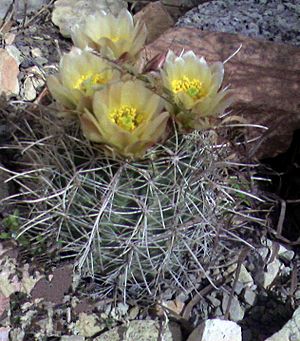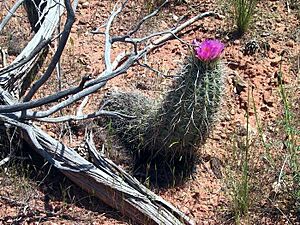Sclerocactus facts for kids
Quick facts for kids Sclerocactus |
|
|---|---|
 |
|
| Sclerocactus wrightiae | |
| Scientific classification | |
| Kingdom: | |
| (unranked): | |
| (unranked): | |
| (unranked): | |
| Order: | |
| Family: | |
| Subfamily: | |
| Tribe: |
Cacteae
|
| Genus: |
Sclerocactus
Britton & Rose
|
| Species | |
|
See text |
|
Sclerocactus is a type of cactus. Its name means "hard cactus" in Greek, because its fruit is hard and dry. There are about 15 different kinds, or species, of Sclerocactus.
These cacti are very good at living in dry places. They are sometimes called 'fishhook cactus' or 'little barrels'.
Contents
What Sclerocactus Looks Like
Sclerocactus plants can be oval-shaped or long and cylinder-shaped. They have stiff stems with bumps called tubercles. These bumps often join together to form ribs.
The stems are covered with sharp spines that grow out of small spots called areoles. Most Sclerocactus species have at least one spine that looks like a hook. Some kinds do not have hooks.
Where Sclerocactus Lives
These plants live in high deserts. You can find them in places like the Colorado Plateau, the Mohave Desert, or the Great Basin. They are very tough plants. They can handle very hot summers and freezing winters. They also survive with very little rain.
The little barrel cactus often grows where water flows sometimes. This could be in dry riverbeds called washes or arroyos. Their seeds need water movement to help them sprout.
They can also grow on ridges where small dips in the ground hold water for a short time.
How Sclerocactus Moves and Survives
The hooked or curved spines on these cacti help them move. The spines also form a tough web that protects the plant.
When there are sudden floods, the hooked spines can catch onto floating debris. This helps the plants get pulled up and carried to new spots. These new spots are usually where water collects.
Many Sclerocactus plants in nature show signs of being moved by water. You might see healed damage on their stems. They are often found growing on their sides where floodwaters left them. This helps them survive in very dry places. They use water movement to find the best spots to grow.
Different Kinds of Sclerocactus
Scientists sometimes disagree on how many species of Sclerocactus there are. This is because some types are very similar. The Flora of North America lists 15 species. Another expert, Anderson, lists 14.
Here are some of the species:
- Sclerocactus brevihamatus
- Sclerocactus glaucus
- Sclerocactus mesae-verdae
- Sclerocactus nyensis
- Sclerocactus papyracanthus
- Sclerocactus parviflorus
- Sclerocactus polyancistrus
- Sclerocactus pubispinus
- Sclerocactus scheeri
- Sclerocactus sileri
- Sclerocactus spinosior
- Sclerocactus uncinatus
- Sclerocactus whipplei
- Sclerocactus wrightiae
Many Sclerocactus species are protected by law. This is because they are in danger of disappearing. It is important to treat all of them as if they are in danger.
Growing Sclerocactus
Sclerocactus plants are not too hard to grow if you know how. They are used to cold weather. They grow in very dry areas that get very cold. They like spots where water flows sometimes or where water collects for a short time.
They grow best in the spring. They like a little bit of plant food during this time. They prefer sandy soil that has lots of minerals. They can handle getting too much water if they are in small pots that drain quickly.
These plants do best outdoors in full sun. They are not usually grown indoors. Their sharp, hooked spines can be dangerous.
Like another cactus called Pediocactus, Sclerocactus plants "deflate" in the fall. They push water out of their bodies and into the soil. This makes them shrink a lot. They need this cold period to bloom well.
Some species, like S. parviflorus, have big, colorful flowers. They put on a beautiful show in early spring.
How Sclerocactus Seeds Sprout
Sclerocactus seeds are tricky to sprout. They have things inside them that stop them from growing right away. To help them sprout, you might need to:
- Make them cold for a long time (cold stratification).
- Soak them in water for a long time.
- Scratch their outer shell (scarification).
Sometimes, the seeds can take up to three years to sprout if they are not treated. Even though they are hard to start from seed, the plants are easy to care for once they are growing.
See also
 In Spanish: Sclerocactus para niños
In Spanish: Sclerocactus para niños


